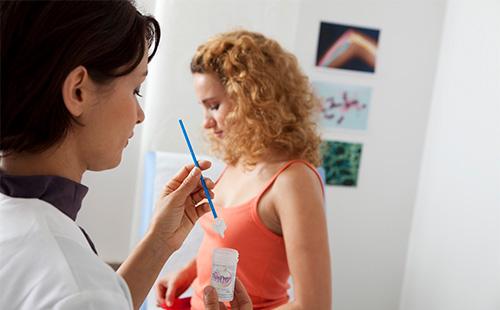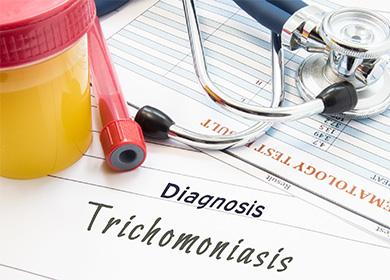The content of the article
In unfavorable conditions, Trichomonas “discard” flagella (help them move along the mucosa) and become inactive, without causing obvious signs of inflammation. Therefore, it is important to conduct an effective course of treatment and not allow microorganisms to mutate. Otherwise, Trichomonas infection is re-activated after a while.
What kind of pathogen
Trichomoniasis - the simplest microorganisms in an active form are present only in human biological fluids. At room temperature they are rapidly inactivated. Trichomonads instantly die under the influence of the following factors:
- when boiling;
- in saline and acidic solutions;
- when exposed to ultraviolet light.
The optimal habitat of Trichomonas is the mucous membranes of the genitals and the genitourinary tract, therefore the concept of urogenital trichomoniasis is often found. Microorganisms can be detected by taking material from the following places:
- vagina;
- cervical canal and cervical surface;
- uterine cavity;
- ovaries and abdominal cavity - with generalization of infection.
How infection occurs and how to treat
Trichomonas infection occurs only during sexual intercourse. The incubation period can last up to two weeks. Moreover, saliva in the oral cavity and gastric juice act on them destructively, therefore oral contacts do not lead to infection, unlikesyphilisfor example, when chancres (ulcers) are found anywhere, often on the tonsils and tongue.
Often women are wondering if there is another way to transmit the infection. The contact-household route of infection is not excluded, however, in practice it is extremely rare. In order to get sick, you must simultaneously use, for example, one towel, linen and other intimate accessories. In this case, the clinical picture of inflammation will not be obvious, more often these are signs vulvita - redness, itching of the external genital area.
Who is at risk
Any woman can get trichomonas colpitis. However, more often it is detected and proceeds with complications in the following groups:
- sexually active - and not using a condom for protection;
- with immunodeficiency - HIV, hepatitis.
Incompletely cured trichomoniasis for some time may not give any signs of infection - it is asymptomatic. Exacerbation can cause the following factors:
- stress, anxiety;
- severe illnesses;
- alcoholic drinks;
- drugs to reduce immunity (hormones, cytostatics).
What are the signs of suspecting
Signs of trichomoniasis in women are more noticeable than in men. The main ones include the following.
- Allocations. Classical discharge in trichomoniasis in women is greenish foamy, but this is not always the case. In a chronic infection, they may be practically absent (especially in men). If there is another sexually transmitted infection (STI) in parallel, the discharge may be marsh, yellow, purulent, profuse or moderate, with an unpleasant odor. Signs of blood may be detected, for example, after sexual intercourse. This is due to the fact that with inflammation of the cervical tissue is excessively vulnerable, the slightest touch causes damage, especially against erosion or dysplasia.
- Itching and burning. Allocations, getting on the mucous membranes of the genitals and skin, cause irritation, itching, pain. When combing, abrasions appear.
- Pain. If the Trichomonas infection is limited only to the vagina and cervix, the pain practically does not bother the woman. But when spreading to the appendages and pelvic peritoneum, pulling pains appear in the lower abdomen, which can give to the sacrum.
- Signs of cystitis. The external opening of the urethra and the entrance to the vagina are close. Therefore, Trichomonas freely penetrate the urinary system, causing signs of cystitis and urethritis - pain, pain when urinating, frequent urination.
- Temperature rise. With a generalization of the infection, the occurrence of abscesses or peritonitis, a fever occurs.
- Menstrual irregularities. Any inflammatory process of the genitals leads toovarian dysfunction, which is fraught with delays, smearing acyclic secretions.
Identification Methods
Diagnosis of trichomoniasis can be carried out in the following ways.
- Inspection of the gynecologist. Since trichomoniasis is manifested in women most often with a vivid clinical picture, an experienced doctor, even when examined on a gynecological chair, can notice its signs by the characteristic foaminess and greenish tint of secretions.
- Smear Fence. Even ordinary smears from the posterior vaginal fornix on the flora in the presence of active trichomonads will show pathogens. When sampling material from the cervical canal (smear analysis for oncocytology), these microorganisms are also detected.
- PCR study. This is the most reliable method. However, in the control study after treatment, it is necessary to carry out real-time PCR. It is this variety that shows active trichomonads. Conventional PCR can be false positive in the presence of “dead” pathogens that are still present in the vagina for some time.
- Bacteriological seeding. When Trichomonas infection is not used due to the complexity of execution and high cost in comparison with other methods.
What is the danger of trichomoniasis in women
Trichomoniasis is dangerous with the following complications:
- inflammation of the cervix with the development of dysplasia, erosion, polyps;
- the formation of abscesses of the ovaries and fallopian tubes;
- progression to chronic endometritis;
- infertility against a background of active infection.
It is important to timely identify and treat the infection, as well as the prevention of the household route of transmission to little girls.
Treatment
Trichomoniasis is a common genital infection. But the range of drugs for it is narrow - most tablets, suppositories based on metronidizal. The list is given in the table.Treatment of trichomoniasis in women provides for the following recommendations:
- therapy with a sexual partner;
- restrictions on intimate relationships during treatment;
- not only local, but also systemic therapy;
- cure control after 14 days, preferably with provocation;
- the sexual partner also needs to do treatment monitoring.
Table - Medicines effective in trichomoniasis
| Active substance | Drugs Based | Schemes and doses |
|---|---|---|
| Metronidazole | - Tablets for oral administration: "Metronidazole", "Trichopolum", "Flagil" "" Klion " - candles in the vagina: “Klion-D”, “Ginokaps”, “Metromikon-Neo”, “Neo-Penotran”; - for intravenous administration - "Metrogil" | - 0.5 g in the form of tablets inside 2 times a day; - Additionally, suppositories in the vagina once at night; - in case of disseminated infection, intravenous injections |
| Tinidazole | - Tablets: "Tinidazole", "Fazizhin" | - Once 2 g of the drug (4 tablets) |
| Clindamycin | - Vaginal suppositories and ointments: "Dalacin", "Clindacin"; - tablets: "Dalacin", "Clindamycin" | - 300 mg of the drug (suppositories or tablets) 1 time per day for 7-10 days |
| Iodine | - Vaginal suppositories: "Ruvidone", "Povidone-iodine", "Betadine" | - 1 candle 2 times a day |
| Hydrogen peroxide | - 3% douching solution | - 2 times a day for 10 days |
| Chlorhexidine | - Vaginal suppositories "Hexicon"; - douching solution | - One candle once a day for 7-10 days or douching |
Why relapse occurs
It is found that Trichomonas periodically appears or disappears in women, reviews on the Internet confirm this. In this case, the question always arises, what is the cause of constant relapses. The main factors are as follows:
- partner reason - he did not undergo treatment completely or for him it was ineffective, in this case trichomoniasis is transmitted during each sexual contact again;
- the reason is a woman - sometimes there is an activation of the infection, which the woman did not completely cure, for example, did not follow the course or dose.
Trichomonas and pregnancy
Trichomonads can be in a woman before pregnancy or appear already during gestation (from the stalls). The tactics and consequences in each case are different.
Before conception
Trichomonas interact with sperm, inactivating them. This can be the cause of unsuccessful attempts to get pregnant along with other infections.
The consequences of trichomoniasis for women are not as serious as, for example, chlamydial or gonococcal infections. Properly treated inflammation does not affect the subsequent reproductive health of a woman. Less common is chronic endometritis or adnexitis, as a rule, in women with prolonged Trichomonas or mixed infection.

During gestation
There are frequent cases of the detection of Trichomonas colpitis at different stages of pregnancy. The consequences for the fetus in this case do not differ from the usual infection. The risk of the following complications increases:
- non-developing pregnancy;
- intrauterine infection;
- outflow of water;
- dysfunction of the placenta.
It is important to identify trichomonads in time and undergo a full course of treatment (acceptable drugs are indicated in the table), which differs in terms. Trichomoniasis is manifested in women during gestation in the same way as outside pregnancy.
Table - How to quickly cure trichomoniasis during pregnancy without harm to the fetus
| Preparations | 1 trimester | 2 trimester | 3 trimester |
|---|---|---|---|
| Preparations based on metronidazole - "Klion-D", "Metromicon-Neo", "Neo-Penotran" | - prohibited | - Only locally (suppositories) | |
| Tinidazole-based preparations | - prohibited | - Undesirable, but possible with risk | |
| Clindamycin-based preparations | - Undesirable, but possible given the perceived risk to the fetus; - better in the form of candles vaginally |
||
| Preparations based on iodine - candles "Povidone-iodine", "Ruvidon", "Betadine" | - Allowed for all terms | ||
| Douching with 3% hydrogen peroxide | |||
| Chlorhexidine-based preparations | |||
ethnoscience
In the fight against infection, you can use folk remedies, however, this is a good addition, but not the main treatment. Effective following recipes that can be easily prepared at home.
- A mixture of herbs. Mix 20 g of lilac, calendula, bird cherry flowers and the same amount of celandine. Pour 300 ml of hot water and let it brew for an hour or two. The resulting solution should be enough for douching once. The course is 10-14 days.
- Sea buckthorn oil. To heal, relieve swelling, itching and inflammation with colpitis, sea buckthorn oil, which must be placed in the vagina on gauze swabs, will help well.
- Horseradish root. You should take 20 g, grind thoroughly and pour boiling water for two hours. After filtering and use the resulting solution for douching at once. The course is two weeks.
Trichomonads are often found as a mixed infection or alone. The treatment regimen for trichomoniasis for women can vary significantly depending on the severity of inflammation and the presence of pregnancy. Prevention of infection involves the use of barrier contraception (e.g., condoms).

